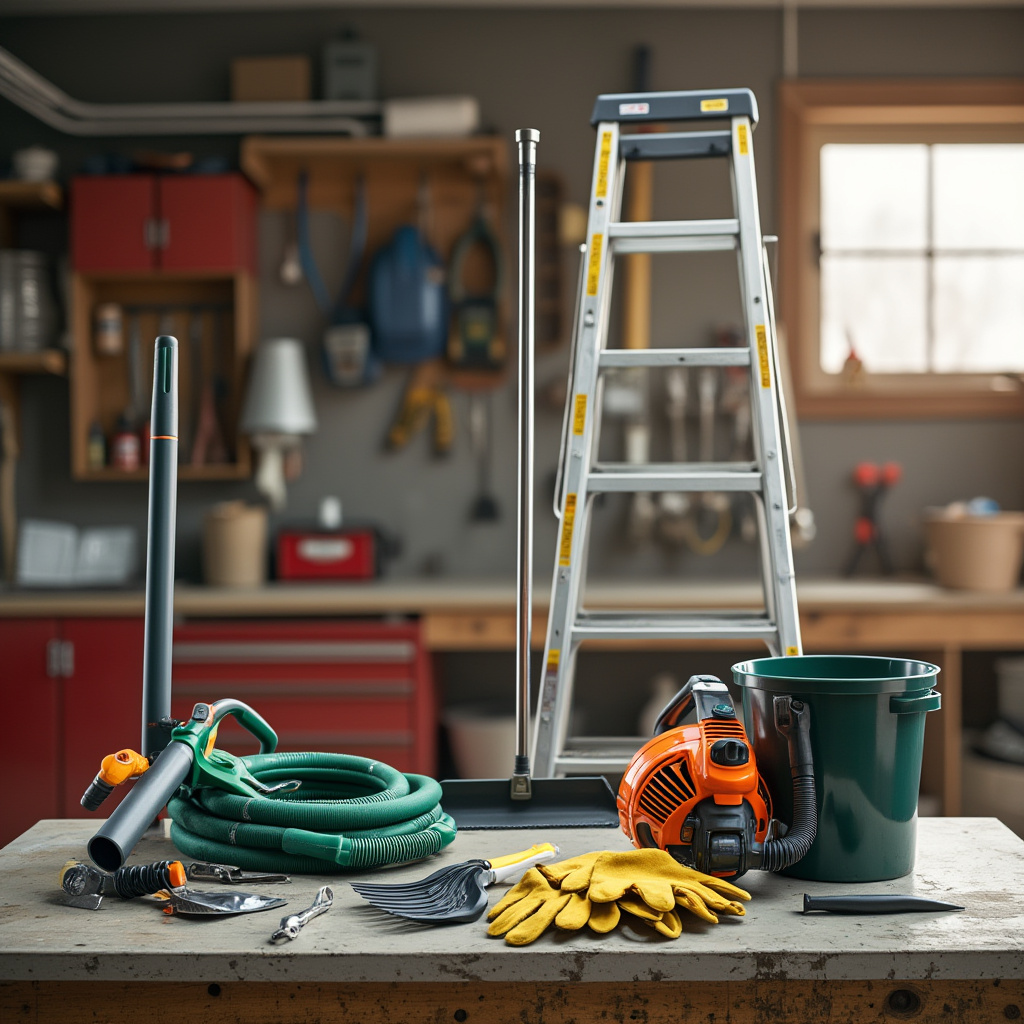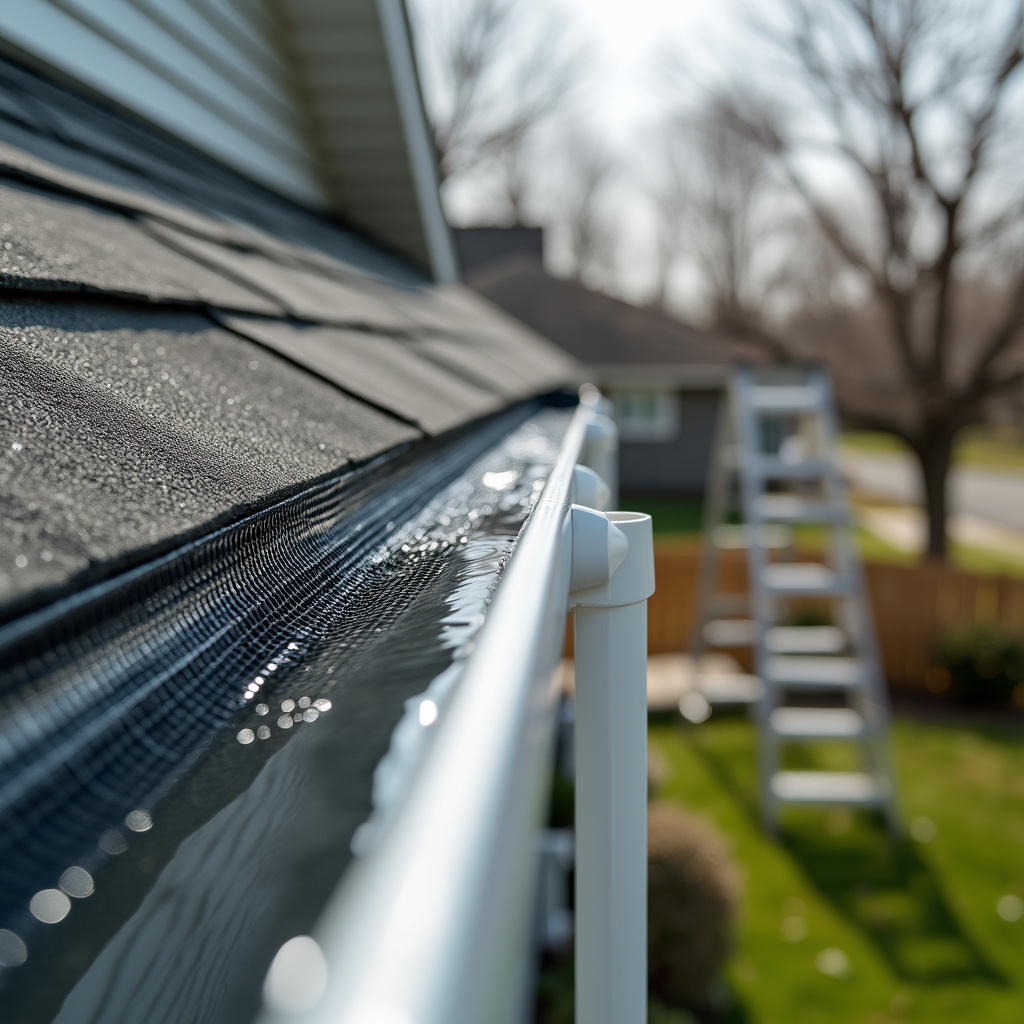Essential Tools and Equipment for Spring Gutter Cleaning
Must-Have Cleaning Tools
Equipping yourself with the right tools can make spring gutter cleaning safer and more efficient. Here are the essentials you shouldn’t start without:
- Ladder: Choose a sturdy, extendable ladder to safely reach gutters. Avoid resting the ladder directly on the gutters to prevent damage.
- Gloves: Heavy-duty work gloves protect your hands from debris, sharp objects, and bacteria lurking in wet leaves.
- Gutter Scoop: A plastic gutter scoop (or even a small garden trowel) helps you remove leaves and sediment effectively, minimizing direct hand contact.
- Garden Hose: Use a hose with a spray nozzle to flush out loose debris and check for proper water flow.
- Safety Goggles: Protect your eyes from splashes, dust, and critters that might be lurking in the gutter.
Quick Reference Table: Must-Have Gutter Cleaning Tools
| Tool | Purpose |
|---|---|
| Ladder | Safe access to gutters |
| Gloves | Hand protection from debris and sharp edges |
| Gutter Scoop | Efficient removal of leaves and buildup |
| Garden Hose | Flushing out debris, testing gutter drainage |
| Safety Goggles | Eye protection from splashes and airborne particles |
With these basics, you’ll be ready to tackle most clogs and buildup with confidence.
Optional Tools to Make Cleaning Easier
While the essentials will get the job done, a few smart upgrades can make your spring gutter cleaning much smoother—and potentially less frequent:
- Leaf Blower Attachments: Some leaf blowers come with gutter cleaning kits that can quickly blast leaves and light debris out of gutters.
- Pros: Fast and effective on dry debris, keeps you off the ladder.
- Cons: Less effective on wet or compacted material, can be messy.
- Power Washers: High-pressure sprayers clean gutters thoroughly and can remove stuck-on grime.
- Pros: Deep cleaning power, effective for end-of-season maintenance.
- Cons: Risk of damaging gutters if pressure is too high, water splatter may create additional cleanup.
- Gutter Guards: Install mesh or brush-style guards to keep larger debris out year-round.
- Pros: Minimizes future cleaning, extends gutter life.
- Cons: Upfront cost, may still require occasional maintenance for small debris.
Should you use these extras? If your home is surrounded by trees or your gutters clog often, these tools are worth considering for added efficiency and long-term maintenance. Otherwise, sticking to the must-haves is sufficient for most spring cleanings.

Step-by-Step Instructions for Safe and Effective Gutter Cleaning
Preparing for the Task Safely
Before you start cleaning, preparing carefully is crucial for your safety—especially when working up high. Inspect your ladder for any damage, loose screws, or missing parts. Ensure it’s tall enough for you to reach the gutters without standing on the top step. Place the ladder on firm, level ground and, if possible, have someone nearby to steady it while you work.
Always wear safety gear like gloves, non-slip shoes, and safety goggles to protect against debris and sharp edges. If you’re using tools like leaf blowers or power washers, double-check that extension cords are rated for outdoor use and are in good condition.
Safety Preparation Checklist
- Inspect ladder for defects.
- Set ladder on stable, level ground.
- Wear gloves, goggles, and sturdy footwear.
- Clear area of obstacles and tripping hazards.
- Inform someone you’re working on the gutters.
- Keep tools within easy reach (preferably in a tool belt).
Taking these steps minimizes accidents and gives you confidence as you begin your gutter cleaning routine.
Cleaning Process Walkthrough
Start by removing large debris like leaves, twigs, or pine needles using a gutter scoop or gloved hands. Work your way along the gutter, dropping debris into a bucket or tarp below to avoid creating a mess around your home. For extra efficiency, use a small garden trowel for packed-in dirt or mud.
Once you’ve cleared the visible debris, take your garden hose and flush out the gutters. Begin at the end opposite the downspout, letting water carry finer sediment and remaining leaves towards the downspout. This step helps reveal any blockages or leaks. If water pools instead of draining, inspect the downspout for clogs—these can often be dislodged by spraying water up from the bottom or using a plumber’s snake.
Tips for an Efficient and Tidy Clean:
- Work in manageable sections.
- Avoid overreaching from the ladder; move it as needed.
- Use a tarp below the workspace for easy cleanup.
- Finish by rinsing any dirt streaks off your siding.

Post-Cleaning Inspection
After your gutters are debris-free and rinsed, a quick inspection can save you headaches down the road. Walk the perimeter of your home and look for:
- Leaks: Pay attention as water runs through gutters; look for drips or pooling around seams and joints.
- Sagging or Damage: Check for sections that bow or appear loose—they may need reattachment or replacement.
- Loose Fasteners: Tighten any visible screws or hangers to keep gutters securely attached.
- Downspout Connections: Ensure downspouts direct water away from the foundation, and that elbows and extensions are secure.
Addressing minor issues now can prevent major water damage and keep your gutters working smoothly all season.
Safety Precautions and Best Practices
Ladder Safety Tips
The right approach to ladder safety is more than just common sense—it’s vital to prevent falls and injuries. When choosing a ladder for gutter cleaning, use a sturdy, non-conductive extension ladder that reaches your gutters comfortably without overreaching. For one-story homes, a step ladder may suffice, but always ensure it’s rated for your weight (including gear and tools).
Tips for Safe Ladder Setup:
- Place the ladder on flat, solid ground. For uneven or soft terrain, use ladder levelers or stabilizers.
- Avoid setting up near doors, windows, or high-traffic areas where someone could accidentally bump the ladder.
- Follow the “4-to-1” rule: for every four feet of ladder height, place the base one foot away from the wall.
- Always face the ladder when climbing and keep three points of contact (two hands and one foot, or two feet and one hand).
Personal Protective Equipment (PPE)
Suiting up with quality PPE drastically reduces your risk of cuts, scrapes, and accidental exposure to bacteria or animal waste. Here’s what you should always wear:
- Gloves: Protect your hands from sharp gutter edges, harmful debris, and unseen critters.
- Eyewear: Safety goggles shield your eyes from dirt, twigs, and splashes.
- Footwear: Wear closed-toe, non-slip shoes or boots. Roofing shoes offer extra grip, especially useful on wet or dewy mornings.
- Long sleeves and pants: Minimize exposure to potential irritants and sharp objects hidden in gutter muck.

When to Hire Professionals
While many homeowners can tackle gutter cleaning, some situations call for expert help. Consider hiring professionals if:
- Your home is multi-story or the gutters are difficult to access safely.
- You’re uncomfortable on ladders, or have a fear of heights.
- Gutters have stubborn clogs or require specialized repairs.
- You have health conditions that put you at greater risk of falls or injury.
- There are signs of structural damage or pests (like birds or wasp nests) in the gutter system.
Hiring a professional not only ensures a thorough job, but also keeps you safe from the hazards associated with heights and complex repairs.
Whenever in doubt, prioritize safety—gutter cleaning is important, but your well-being is always more valuable.
Maintenance Tips to Keep Gutters Functioning Well Year-Round
Regular Inspection and Cleaning Frequency
To prevent messy clogs and costly water damage, consistency with gutter maintenance is key. As a general rule:
- Spring: Clean gutters after pollen and seed drop, usually once between late March and June.
- Fall: Clean after most leaves have fallen, typically in late October or November.
- Heavy Rain or Storms: Inspect gutters for debris or damage after significant weather events.
- Additional Checks: If your property has many overhanging trees, increase cleanings to quarterly for optimal flow.
Regular inspection—at least every three months—lets you spot problems like leaks, sagging, and debris buildup before they escalate.
Installing Gutter Guards and Downspout Screens
Gutter guards and downspout screens are proactive defenses against ongoing debris accumulation. These systems help block leaves and twigs while letting water flow freely. Here are some benefits:
- Reduce Cleaning Frequency: You’ll spend less time up on the ladder.
- Prevent Large Clogs: By keeping out the biggest offenders—twigs, leaves, and bird nests.
- Extend Gutter Life: Guards help prevent rust and corrosion due to standing debris.
- Improve Water Flow: Less debris means fewer backups and overflows.
Keep in mind, though, that even the best guards require occasional inspection and maintenance to stay effective.

Seasonal Maintenance Checklist
Staying ahead of potential problems is easy with a year-round schedule. Here’s a simple table to guide routine gutter maintenance and keep your system in top condition:
| Season | Maintenance Task | Timing/Notes |
|---|---|---|
| Spring | Clean gutters, inspect hangers and seams | After pollen/seed drop |
| Summer | Check for leaks and blockages; minor cleanups | After storms or mid-season |
| Fall | Major gutter cleanout, check downspouts for clogs | After major leaf fall |
| Winter | Inspect for ice dams, clear any late debris | After first freeze or heavy snow |
| Year-Round | Inspect guards/screens, test water flow after rain | Quarterly or after major rain |
By anchoring your schedule to the seasons, you’ll protect your home from water damage and prolong the life of your gutter system—no matter what the weather brings.
